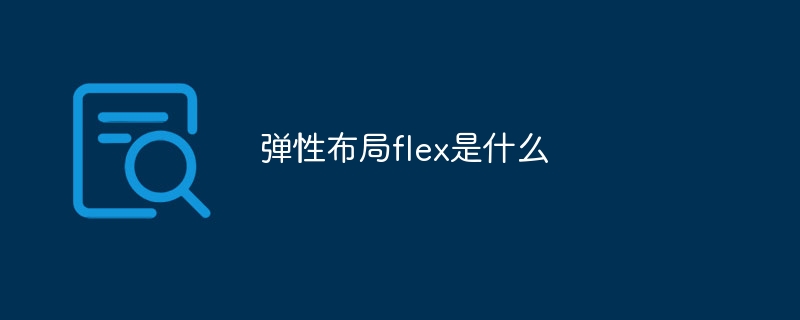Home >Web Front-end >Front-end Q&A >What is flexible layout flex?
What is flexible layout flex?
- 百草Original
- 2023-11-21 14:22:001637browse
Flexible layout Flex is a modern web page layout method. It provides a more flexible and efficient layout method and can solve many problems that are difficult to handle with traditional layout methods. Flexbox is a one-dimensional layout model that organizes items in a container in a row or column and automatically adjusts the arrangement of items based on the size of the container and the characteristics of the items. The main features of flexible layout flex include: 1. Main axis and cross axis; 2. Alignment and distribution; 3. Properties of flexible items; 4. Line wrapping and reverse; 5. Space distribution and size adjustment, etc.

The operating system for this tutorial: Windows 10 system, DELL G3 computer.
Flexible layout, also known as Flexbox, is a modern web page layout method. It provides a more flexible and efficient layout method and can solve many problems that are difficult to handle with traditional layout methods. Flexbox is a one-dimensional layout model that organizes items in a container in a row or column and automatically adjusts the arrangement of items based on the size of the container and the characteristics of the items.
The main features of Flexbox include:
1. Main axis and cross axis: Flexible layout divides the container into two directions, the main axis and the cross axis. The main axis is the main direction in which items are arranged, while the cross axis is the direction perpendicular to the main axis. By setting the flex-direction property, you can define the direction of the main axis, thereby determining the arrangement direction of items.
2. Alignment and distribution: In flexible layout, the alignment and distribution of items can be controlled through the justify-content and align-items attributes. The justify-content property defines the alignment of items on the main axis, while the align-items property defines the alignment of items on the cross axis. These properties can center the item horizontally and vertically, move it to the left or right, etc.
3. Properties of flexible items: Properties of flexible items include flex-grow, flex-shrink and flex-basis. flex-grow defines the enlargement ratio of the item when there is insufficient space, flex-shrink defines the shrinkage ratio of the item when there is excess space, and flex-basis defines the default size of the item. These properties can be used to control the scalability and resizing of the project.
4. Line wrap and reverse: By setting the flex-wrap attribute, you can control whether the item wraps or not. If set to flex-wrap: wrap, items will wrap within the container. In addition, you can use the flex-reverse attribute to reverse the order of items and implement reverse layout.
5. Spatial distribution and size adjustment: By setting the align-content and justify-content properties, you can control the spatial distribution and alignment of multi-line items. In addition, you can also use the flex-basis, flex-grow and flex-shrink properties to adjust the size of the item to achieve a more flexible layout effect.
6. Cross-axis order: In flexible layout, in addition to being determined by the main axis direction, the order of items can also be adjusted by setting the order of the cross-axis. The order in which items are arranged can be defined using the flex-start, flex-end, flex-left, and flex-right properties, which specify the starting or ending position of the items on the cross axis.
7. Cross-axis alignment: The alignment of the cross-axis can be set individually through the align-self attribute. This allows us to align items on the cross axis, overriding the alignment settings in the container. The align-self attribute can be set to auto, flex-start, flex-end, center, baseline or stretch.
8. Additional rules for elastic containers: For elastic containers, there are some additional rules that need to be followed. For example, a flex container can use the align-items and justify-content properties to control the alignment of items. Additionally, flex containers have an extra sub-item: flex separators. This separator can be used to control the spacing between items, and can be used to align the first item to the edge of the flex container and the last item to the edge of the flex container by setting justify-content: space-between;.
9. Nested flexible containers: In flexible layout, we can nest a flexible container within another flexible container. In this case, the inner container inherits the outer container's alignment, main-axis orientation, and wrapping properties. However, the cross axis of the inner container is always perpendicular to the main axis of the outer container.
Flexbox is a very powerful and flexible layout method that can simplify the process of web page layout and improve development efficiency. By using Flexbox, developers can more easily implement complex layout designs and better adapt to various screen sizes and device types.
The above is the detailed content of What is flexible layout flex?. For more information, please follow other related articles on the PHP Chinese website!

